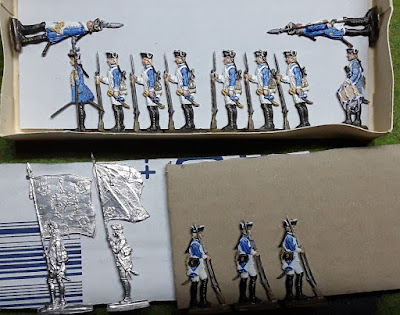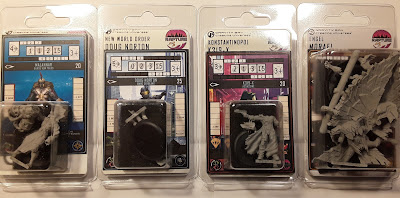The butterfly is fluttering again (at the end of this post), so here are some updates from my workbench. As always, click on the photos to enlarge.
(Half-)finished work is from my Zinna project, where a few minis are waiting for the rest of their unit to be added:
 |
| The first Prussian half-battery ready for action |
 |
| First half of Nadasdy hussars (not based yet because these minis will be mixed up with the remaining eight hussars). |
Another unit that is not yet half complete is the Baden-Baden infantry regiment (2 batallions).
 |
| Back in the cardboard box, waiting for their comrades before being based: the first painted Baden-Baden musketeers |
 |
| The next batch of Baden-Baden infantry, basecoated and half painted (the white cuffs, waistcoats and lapels are hard to see here, though). |
In addition, I have recently continued an old WH40K project, the Tallarn inspired Si Fi Desert Rats:
 |
| The third wheeled Chimera equipped with a Griffon large caliber mortar after the first wash, waiting for another wash, highlights amd detailing. |
And then the butterfly: I recently ran across a new Sci Fi skirmish wargame from some enthusiasts from Germany, called Rapture by Gravity Bay. The artwork is gorgeous, the story (near future post-pandemic SciFi) fascinating and, although I don't play much, still motivating for me: the rules look eminently playable, fast paced and modern. A sneak preciew of the game with rulebook and printable counters and proxies for the minis is available here.
After a 12 month+ grassroot campaign where the game was presented at big shows and in various gaming clubs (look for "Gravity Bay Rapture" on Youtube for examples), the game is about to go to Kickstarter for funding of a first normal production run.
Until then, a handful of minis is already available in the Gravity Bay online shop today, so I couldn't resist ordering a few to try them out. I will post a separate unboxing/first impressions summary later, so here just are a couple photos to wet your appetite.
 |
| The first boosters |
 |
| The first minis assembled, ready to be cleaned and basecoated. From left to right (in my words, check the website for the official faction names): Human professional soldier, Atlantis water dweller with a mining water drill repurposed into a short distance weapon (how cool is that?), a really angry Angel (maybe because the four heads keep up a permanent shouting match among themselves?), and a robotic police AI which can fight for every faction and keeps changing its mind on tactical priorities. |

Hello,
AntwortenLöschenvery nice work on flats on your blog, on other figs too. Flats : I was surprised by the colours, so I searched and finally found your post about your use of watercolours. Could you explain a bit how this works, which brand(s) you use for colours and varnishes? I have painted many figs (6mm/10mm/28mm) in acrylics, some flats in oil, never heard about watercolors for figures !
Bravo for the interesting blog(makes me think to paint 6mm minor SYW states armies), and thank you ahead for the answers.
Hi, thanks for your comments and questions. I learned the water color technique from another collector and painter I met in Munich when I was a student there. There is nothing brand specific about this technique (and I'm not sue German brand names are helpful), the main ingredients are
AntwortenLöschen1) a solid basecoat of the kind you use on cars (the layer that goes on the bare metal before applying the color layers). I actually get this from the DIY aisle for car accessories. I use light grey. On top of that I use a normal tabletop / modelling basecoat in white, e.g. the one from Vallejo or Games Workshop.
2) the right kind of water color: not the very expensive but very translucent "real" artists water colors which come in small blocks, and not the cheap, really thick kids' watercolors. I still use the one shown in http://kolyusha.blogspot.com/2016/01/workbench-stages-in-life-of-historical.html which we were made to buy in high school more than 30 years ago... I think its contemporary equivalent would be this one: https://www.pelikan.com/pulse/Pulsar/de_CH.Store.displayStore.216822./der-aquarellkasten-24-von-pelikan
3) because the water colors remain water soluble after drying you need a really solid coat of transparent varnish to protect them. I use glossy varnish because I like the shiny look, but matte would work, too. Again I use standard run-of-the-mill spray varnish from modelling or artists suppliers, nothing fancy at all.
The secret to making the minis look ok is to paint cleanly, use the white basecoat and the translucence of the colors to get a color coating, highlights (where the white shines through) and shades (where the color collects in the deeper partsmof the mini) in a single step. This limits how hard the contrasts between base, highlight and shadows can be and means you will necer get truely great exhibition pieces, this is clearly a technique for large numbers of minis for bigger dioramas or mass battle tabletop games. I still try to create some dazzle and points that attract the eye with careful freehand on special items like flags, drummers uniforms etc.
Hi,
AntwortenLöschenthank you very much for the answers. I was surprised you used 2 undercoats.I thought you used expensive watercolours because of the specific contrasts the Zinnfiguren/flats need.Point well made. (as an aside I liked Pelikan Plaka casein colours for terrain and such, I wonder why Pelikan discontinued them).
I was surprised you used 2 undercoats on flats.The sort of material/undercoat for cars you mention is the one I have used for years on 6mm figures (grey or white)(it's called Motip). But on these tiny figures, only one coat.
Your technique looks interesting for painting armies. It would be very hard to obtain the same results with enamel on figures without undercoat (as in the good old days, if I'm right).
I'm a bit frightened :-)
when I read that the secret is to
"paint cleanly" with watercolours on flats.
Not sure I can do that... But it's certainly something I'll try one day. Because I have some SYW flats and also some Thirty Years War flats figures too (oh My !).
With all good wishes for the New Year (it's a bit late for Christmas, sorry, I missed your answer. I suppose you had many figures that day !).
Thank you again.
And keep up the good work.
P.S. :
The family website is here :
http://vendheaume.fighters.pagesperso-orange.fr/